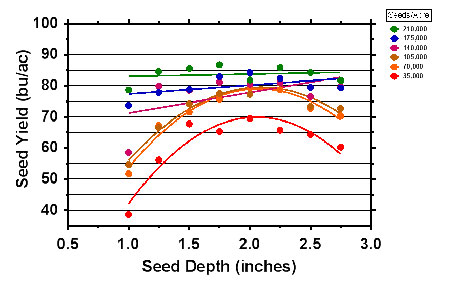As of Monday 6% of Nebraska soybeans had been planted, according to the USDA National Ag Statistics Service. Nebraska research has demonstrated the value of planting soybeans early. Now producers are asking: "If I plant my soybeans early, how deep should I plant them?"
 Figure 1. 2013 yield from soybean seeding depth and seeding rate study. This data was from a center-pivot irrigated no-till field near Mead, 30-inch rows planted April 29, 2013 to Pioneer 93M11. Additional graphs cannot be shared at this time as this study has not been published yet in a peer-reviewed journal. In general, all site-years showed optimal yields at the 1.75-inch seeding depth in conventional, no-till, and strip-till fields. In general, reduced yields were observed at planting depths shallower than 1.25 inches, at seeding rates of 35-105K, and deeper than 2.25 inches at those same populations.
Figure 1. 2013 yield from soybean seeding depth and seeding rate study. This data was from a center-pivot irrigated no-till field near Mead, 30-inch rows planted April 29, 2013 to Pioneer 93M11. Additional graphs cannot be shared at this time as this study has not been published yet in a peer-reviewed journal. In general, all site-years showed optimal yields at the 1.75-inch seeding depth in conventional, no-till, and strip-till fields. In general, reduced yields were observed at planting depths shallower than 1.25 inches, at seeding rates of 35-105K, and deeper than 2.25 inches at those same populations.Research we conducted at UNL looked at several factors including soybean populations and planting depths over a three-year period (2011-2013). This research was conducted at different locations over the years including Clay Center, Lincoln, Cedar Bluffs, and Mead. These site-years represent a wide range of early season growing conditions, from wet-cold to dry-warm; hence, results are applicable over a wide range of conditions. They also represent conventional, strip-till, and no-till systems. We looked at numerous factors but because this research has not yet been published in a peer-reviewed scientific journal, we can only share specific information regarding the planting depth studies.
All soybean plots were planted into 30-inch rows with planting dates of May 30 and June 4, 2011; May 1, 2012; and April 29, 2013. Later planting dates in 2011 were due to cold-wet planting conditions in conventional-till fields and the inability to get into those fields earlier. Planting depths of 1 inch and 1.25, 1.5, 1.75, 2.0, 2.25, and 2.5 inches were evaluated in 2011 and an additional planting depth of 2.75 inches was added in 2012 and 2013. Plant populations also were evaluated with each planting depth; these included seeding rates of 35,000; 70,000; 105,000; 140,000; 175,000; and 210,000 seeds/acre.
Many producers plant soybeans shallow (as long as moisture is present) thinking that this will result in quick emergence. While that may be the case, shallow planting also may reduce stands. One of the study's hypotheses was that planting deeper would buffer soil temperature and moisture and protect newly emerged seedlings from frost and freeze damage, particularly when planting early in the season.
While we can't show all the data here, the results in fact showed the optimal planting depth was around 1.75 inches. The data also showed that this planting depth was consistent for all site-years of the study. Shallow depths of less than 1.25 inches with seeding rates of 35K-105K resulted in lower yields, as did deeper planting depths of 2.25 inches or greater at these seeding rates. (See Figure 1).
Conclusion
Across all site-years, regardless of early or late planting dates or tillage type, a planting depth of 1.75 inches maximized soybean yields.
Acknowledgement
The researchers and authors would like to thank the Nebraska Soybean Board for their support of this research project.
Jim Specht, UNL Professor of Agronomy and Horticulture
Jenny Rees, UNL Extension Educator
Keith Glewen, UNL Extension Educator
Patricio Grassini, UNL Extension Cropping Systems Agronomist
4/30/2014